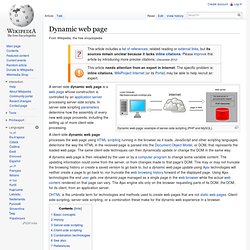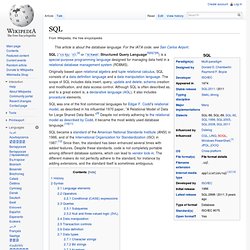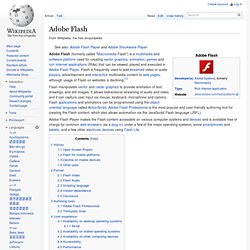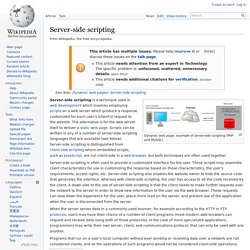

FileZilla - The free FTP solution. Dynamic web page. Dynamic web page: example of server-side scripting (PHP and MySQL).

A client-side dynamic web page processes the web page using HTML scripting running in the browser as it loads. JavaScript and other scripting languages determine the way the HTML in the received page is parsed into the Document Object Model, or DOM, that represents the loaded web page. The same client-side techniques can then dynamically update or change the DOM in the same way. DHTML is the umbrella term for technologies and methods used to create web pages that are not static web pages.
Ajax (programming) Ajax is not a single technology, but a group of technologies.

HTML and CSS can be used in combination to mark up and style information. The DOM is accessed with JavaScript to dynamically display, and allow the user to interact with, the information presented. JavaScript and the XMLHttpRequest object provide a method for exchanging data asynchronously between browser and server to avoid full page reloads. In 1996, the iframe tag was introduced by Internet Explorer to load or to fetch content asynchronously. In 1998, Microsoft Outlook Web App team implemented the first component XMLHTTP by client script. Google made a wide deployment of standards-compliant, cross browser Ajax with Gmail (2004) and Google Maps (2005).[6] The term "Ajax" was publicly stated on 18 February 2005 by Jesse James Garrett in an article titled "Ajax: A New Approach to Web Applications", based on techniques used on Google pages.[1]
SQL. SQL (/ˈɛs kjuː ˈɛl/,[4] or /ˈsiːkwəl/; Structured Query Language[5][6][7][8]) is a special-purpose programming language designed for managing data held in a relational database management system (RDBMS).

Originally based upon relational algebra and tuple relational calculus, SQL consists of a data definition language and a data manipulation language. The scope of SQL includes data insert, query, update and delete, schema creation and modification, and data access control. Although SQL is often described as, and to a great extent is, a declarative language (4GL), it also includes procedural elements. SQL was one of the first commercial languages for Edgar F. Codd's relational model, as described in his influential 1970 paper, "A Relational Model of Data for Large Shared Data Banks History[edit] SQL was initially developed at IBM by Donald D. In the late 1970s, Relational Software, Inc. Syntax[edit] Adobe Flash. Flash manipulates vector and raster graphics to provide animation of text, drawings, and still images.

It allows bidirectional streaming of audio and video, and it can capture user input via mouse, keyboard, microphone and camera. Flash applications and animations can be programmed using the object-oriented language called ActionScript. Adobe Flash Professional is the most popular and user-friendly authoring tool for creating the Flash content, which also allows automation via the JavaScript Flash language (JSFL).
History[edit] Open Screen Project[edit] As of February 2009[update], the specifications removing the restrictions on the use of SWF and FLV/F4V specs have been published.[6] The Flash Cast protocol—now known as the Mobile Content Delivery Protocol—and AMF protocols have also been made available,[6] with AMF available as an open source implementation, BlazeDS. As of 2012[update], the Open Screen Project is no longer accepting new applications according to partner BSQuare. Server-side scripting. Dynamic web page: example of server-side scripting (PHP and MySQL).

Server-side scripting is a technique used in web development which involves employing scripts on a web server which produce a response customized for each user's (client's) request to the website. The alternative is for the web server itself to deliver a static web page. Scripts can be written in any of a number of server-side scripting languages that are available (see below). Server-side scripting is distinguished from client-side scripting where embedded scripts, such as JavaScript, are run client-side in a web browser, but both techniques are often used together.
Server-side scripting is often used to provide a customized interface for the user. Programs that run on a user's local computer without ever sending or receiving data over a network are not considered clients, and so the operations of such programs would not be considered client-side operations. Client-side scripting. By viewing the file that contains the script, users may be able to see its source code.
Many web authors learn how to write client-side scripts partly by examining the source code for other authors' scripts. Due to security restrictions, client-side scripts may not be allowed to access the user's computer beyond the web browser application. Techniques like ActiveX controls can be used to sidestep this restriction. Client-side scripting is not inherently unsafe. Users, though, are encouraged to always keep their web browsers up-to-date to avoid exposing their computer and data to new vulnerabilities.